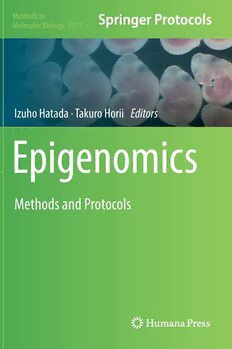Table Of ContentMethods in
Molecular Biology 2577
Izuho Hatada · Takuro Horii Editors
Epigenomics
Methods and Protocols
M M B
ETHODS IN OLECULAR IO LO GY
SeriesEditor
JohnM.Walker
School of Lifeand MedicalSciences
University ofHertfordshire
Hatfield, Hertfordshire, UK
Forfurther volumes:
http://www.springer.com/series/7651
For over 35 years, biological scientists have come to rely on the research protocols and
methodologiesinthecriticallyacclaimedMethodsinMolecularBiologyseries.Theserieswas
thefirsttointroducethestep-by-stepprotocolsapproachthathasbecomethestandardinall
biomedicalprotocolpublishing.Eachprotocolisprovidedinreadily-reproduciblestep-by-
step fashion, opening with an introductory overview, a list of the materials and reagents
neededtocompletetheexperiment,andfollowedbyadetailedprocedurethatissupported
with a helpful notes section offering tips and tricks of the trade as well as troubleshooting
advice. These hallmark features were introduced by series editor Dr. John Walker and
constitutethekeyingredientineachandeveryvolumeoftheMethodsinMolecularBiology
series. Tested and trusted, comprehensive and reliable, all protocols from the series are
indexedinPubMed.
Epigenomics
Methods and Protocols
Edited by
Izuho Hatada and Takuro Horii
Institute for Molecular and Cellular Regulation, Gunma University, Maebashi, Gunma, Japan
Editors
IzuhoHatada TakuroHorii
InstituteforMolecularandCellular InstituteforMolecularandCellularRegulation
Regulation GunmaUniversity
GunmaUniversity Maebashi,Gunma,Japan
Maebashi,Gunma,Japan
ISSN1064-3745 ISSN1940-6029 (electronic)
MethodsinMolecularBiology
ISBN978-1-0716-2723-5 ISBN978-1-0716-2724-2 (eBook)
https://doi.org/10.1007/978-1-0716-2724-2
©TheEditor(s)(ifapplicable)andTheAuthor(s),underexclusivelicensetoSpringerScience+BusinessMedia,LLC,part
ofSpringerNature2023
Thisworkissubjecttocopyright.AllrightsaresolelyandexclusivelylicensedbythePublisher,whetherthewholeorpart
of the material is concerned, specifically the rights of translation, reprinting, reuse of illustrations, recitation,
broadcasting,reproductionon microfilmsorinanyotherphysicalway,andtransmissionorinformation storageand
retrieval,electronicadaptation, computersoftware,orbysimilar ordissimilar methodologynow knownorhereafter
developed.
Theuseofgeneraldescriptivenames,registerednames,trademarks,servicemarks,etc.inthispublicationdoesnotimply,
evenintheabsenceofaspecificstatement,thatsuchnamesareexemptfromtherelevantprotectivelawsandregulations
andthereforefreeforgeneraluse.
Thepublisher,theauthors,andtheeditorsaresafetoassumethattheadviceandinformationinthisbookarebelievedto
betrueandaccurateatthedateofpublication.Neitherthepublishernortheauthorsortheeditorsgiveawarranty,
expressedorimplied,withrespecttothematerialcontainedhereinorforanyerrorsoromissionsthatmayhavebeen
made.Thepublisherremainsneutralwithregardtojurisdictionalclaimsinpublishedmapsandinstitutionalaffiliations.
ThisHumanaimprintispublishedbytheregisteredcompanySpringerScience+BusinessMedia,LLC,partofSpringer
Nature.
Theregisteredcompanyaddressis:1NewYorkPlaza,NewYork,NY10004,U.S.A.
Preface
Epigeneticmodificationsturngenesonandoffanddifferbetweenindividuals,tissues,and
even cells, contributing to their unique characteristics. Diseases can also stem from epige-
neticmedicationsthatcauseabnormalactivationorsilencingofgenes.Theadventofnext-
generationsequencing(NGS)technologyattheturnofthiscenturyhasmadeitpossibleto
analyze epigenetic modifications across the entire genome, inaugurating the dawn of the
epigenomics era. Ongoing research using NGS technology continues to show that epige-
netic changes are at the basis of many human diseases. However, it was not until the early
2010s that a versatile method emerged to identify the epigenomic changes that cause a
specific disease. Methods that enable the switching on and off of specific genes artificially
alsoholdgreatpromisefordeterminingwhichgene(s)isresponsibleforacertaindiseaseand
couldalsohaveawiderangeofmedicalandbiotechnologicalapplications.
Theclusteredregularlyinterspacedshortpalindromicrepeats(CRISPR)/Cas9system
frombacteriahasbeensuccessfullyadaptedforRNA-guidedgenomeeditinginawiderange
of organisms. Cas9 cleaves DNA upon recognition of a target sequence by the gRNA.
Conversely, dCas9, a nuclease-defective Cas9, binds specifically to the target sequence
without cleaving it. Therefore, dCas9 can recruit epigenetic enzymes to a specific gene
andintroducechangesinasingleepigeneticmark.Thisnewtechnologyprovidesaplatform
for the specific manipulation of the epigenome, a capability that could only have been
dreamedofafewyearsago.
Thisbookprovidesacomprehensivecollectionofprotocolsforepigenomicresearch.It
consistsoftwomainparts.Thefirstpartdescribesthemethodsusedtoanalyzeepigenomic
modifications,suchasDNAmethylation(Chapters1,2,and3),histonemodifications,and
chromatinstructure(Chapters4,5,6,7,8,9,10,and11).Theseconddescribesmethods
formanipulatingtheepigenome,suchasplatformsforepigenomeediting(Chapters12,13,
14, and 15), inducible systems for epigenome editing (Chapter 16), and epigenetically
modifiedanimals(Chapters17,18,19,and20).
Wethankalloftheauthorsfor theiroutstandingcontributionstothisbook.Onbehalf
of all of us, we hope that you will find the information in this book useful and that it will
furtherexpandtheutilityandscopeofepigenomicsresearch.
Maebashi,Gunma,Japan IzuhoHatada
TakuroHorii
v
Contents
Preface ..................................................................... v
Contributors................................................................. ix
PART I ANALYSIS OF THE EPIGENOME: DNA METHYLATION
1 DNAMethylationAnalysisUsingBisulfitePyrosequencing .......... ........ 3
KenHigashimoto,SatoshiHara,andHidenobuSoejima
2 Post-bisulfiteAdaptorTaggingBasedonanssDNALigation
Technique(tPBAT) ........ ........ ....... ....... ........ ....... ........ 21
FumihitoMiura,YukikoShibata,MikiMiura,
andTakashiIto
3 ReducedRepresentationBisulfiteSequencing(RRBS)...... .. ....... ........ 39
KazuhikoNakabayashi,MichihiroYamamura,
KeitaHaseagawa,andKenichiroHata
PART II ANALYSIS OF THE EPIGENOME: HISTONE MODIFICATION
AND CHROMATIN STRUCTURE
4 ChromatinImmunoprecipitationSequencing(ChIP-seq)forDetecting
HistoneModificationsandModifiers........ ....... .... .... ...... ...... ... 55
ShinjiroHino,TetsuyaSato,andMitsuyoshiNakao
5 ATAC-SeqAnalysisofAccessibleChromatin:FromExperimentalSteps
toDataAnalysis .... ....... ........ ....... ....... ........ ....... ........ 65
MayuTatara,TaiyoIkeda,SatoshiH.Namekawa,
andSoMaezawa
6 Low-InputCUT&RUNforMouseOocytesandPreimplantation
Embryos........... ....... ........ ....... ....... ....... ....... ..... .... 83
RyoyaHayashiandAzusaInoue
7 ImagingChromatinAccessibilitybyAssayofTransposase-Accessible
ChromatinwithVisualization ....... ....... ....... ........ ....... ........ 93
YusukeMiyanari
8 STREAMING-TagSystem:TechnologytoEnableVisualization
ofTranscriptionalActivityandSubnuclearLocalizationofSpecific
EndogenousGenes......... ........ ....... ....... ........ ....... ........ 103
HiroakiOhishiandHiroshiOchiai
9 BioinformaticsPipelinesforIdentificationofSuper-Enhancers
and3DChromatinContacts ..... ... ....... ....... ........ ....... ........ 123
AkihikoSakashita,ChikaraTakeuchi,SoMaezawa,
andSatoshiH.Namekawa
10 AMethodforDetectionofSomaticLINE-1InsertionsattheSingle-Cell
LevelfromPostmortemHumanBrain....... ....... ........ ....... ........ 147
MikiBundoandKazuyaIwamoto
vii
viii Contents
11 SolubilizationofMouseSpermChromatinforSequencingAnalyses
UsingaChaperonProtein .......... ....... ....... ........ ....... ........ 161
YukoFukuda,KeishiShintomi,KosukeYamaguchi,
YasuhiroFujiwara,andYukiOkada
PART III MANIPULATION OF THE EPIGENOME: PLATFORMS
FOR EPIGENOME EDITING
12 EfficientTargetedDNAMethylationwithdCas9-Coupled
DNMT3A-DNMT3LMethyltransferase..... ....... ........ ....... ........ 177
PavelBashtrykov,NivethikaRajaram,andAlbertJeltsch
13 RegulationofGeneExpressionUsingdCas9-SunTagPlatforms...... ........ 189
SumiyoMorita,TakuroHorii,andIzuhoHatada
14 ConcatenatedCoiled-CoilTagforHighlyEfficient,SmallMolecule-Inducible
UpregulationofEndogenousMammalianGenes .... ........ .... ... ...... .. 197
TinaLebarandRomanJerala
15 Design,Construction,andValidationofTargetedGeneActivation
withTREESysteminHumanCells......... ....... ........ ....... ........ 211
AtsushiKunii,TakashiYamamoto,andTetsushiSakuma
PART IV MANIPULATION OF THE EPIGENOME: INDUCIBLE SYSTEM
FOR EPIGENOME EDITING
16 ASplitCRISPR–Cpf1PlatformforInducibleGeneActivation ....... ........ 229
TakahiroOtabe,YutaNihongaki,andMoritoshiSato
PART V MANIPULATION OF THE EPIGENOME: EPIGENETICALLY
MODIFIED ANIMALS
17 TargetedDNAMethylationinMouseEarlyEmbryos........ ....... ........ 243
TaigaYamazaki,YuHatano,NoritadaKobayashi,
andKazuoYamagata
18 GenerationofEpigeneticDiseaseModelMicebyTargeted
DemethylationoftheEpigenome.... ....... ....... .... .... ... .... ........ 255
TakuroHorii,SumiyoMorita,andIzuhoHatada
19 InVivoTissue-SpecificDNADemethylationinMouseLiver
ThroughaHydrodynamicTailVeinInjection ....... ........ ....... ........ 269
KoshiHashimotoandNozomiHanzawa
20 TargetedManipulationofHistoneModificationinMedakaEmbryos ......... 279
HirotoS.Fukushima,HiroyukiTakeda,
andRyoheiNakamura
Index ...................................................................... 295
Contributors
PAVELBASHTRYKOV • InstituteofBiochemistryandTechnicalBiochemistry,Departmentof
Biochemistry,UniversityofStuttgart,Stuttgart,Germany
MIKIBUNDO • DepartmentofMolecularBrainScience,GraduateSchoolofMedicalSciences,
KumamotoUniversity,Kumamoto,Japan
YASUHIROFUJIWARA • InstituteforQuantitativeBiosciences,TheUniversityofTokyo,Tokyo,
Japan
YUKOFUKUDA • InstituteforQuantitativeBiosciences,TheUniversityofTokyo,Tokyo,Japan
HIROTOS.FUKUSHIMA • DepartmentofBiologicalSciences,GraduateSchoolofScience,The
UniversityofTokyo,Tokyo,Japan
NOZOMIHANZAWA • DepartmentofDiabetesandEndocrinology,NationalDisasterMedical
Center,Tachikawa,Tokyo,Japan
SATOSHIHARA • DivisionofMolecularGeneticsandEpigenetics,Departmentof
BiomolecularSciences,FacultyofMedicine,SagaUniversity,Saga,Japan
KEITAHASEAGAWA • DepartmentofObstetricsandGynecology,KeioUniversitySchoolof
Medicine,Shinjuku,Tokyo,Japan
KOSHI HASHIMOTO • DepartmentofDiabetes,EndocrinologyandHematology,Dokkyo
MedicalUniversitySaitamaMedicalCenter,Koshigaya,Saitama,Japan
KENICHIROHATA • DepartmentofMaternal-FetalBiology,ResearchInstitute,National
Center forChildHealthandDevelopment,Setagaya,Tokyo,Japan
IZUHO HATADA • LaboratoryofGenomeScience,BiosignalGenomeResourceCenter,
InstituteforMolecularandCellularRegulation,GunmaUniversity,Maebashi,Gunma,
Japan
YUHATANO • FacultyofBiology-OrientedScienceandTechnology,KindaiUniversity,
Kinokawa,Wakayama,Japan
RYOYAHAYASHI • LaboratoryforEpigenomeInheritance,RIKENCenter forIntegrative
MedicalSciences,Yokohama,Kanagawa,Japan;TokyoMetropolitanUniversity,Hachioji,
Tokyo,Japan
KENHIGASHIMOTO • DivisionofMolecularGeneticsandEpigenetics,Departmentof
BiomolecularSciences,FacultyofMedicine,SagaUniversity,Saga,Japan
SHINJIROHINO • DepartmentofMedicalCellBiology,InstituteofMolecularEmbryologyand
Genetics,KumamotoUniversity,Kumamoto,Japan
TAKUROHORII • LaboratoryofGenomeScience,BiosignalGenomeResourceCenter,Institute
forMolecularandCellularRegulation,GunmaUniversity,Maebashi,Gunma,Japan
TAIYOIKEDA • DepartmentofAppliedBiologicalScience,TokyoUniversityofScience,Chiba,
Japan
AZUSAINOUE • LaboratoryforEpigenomeInheritance,RIKENCenter forIntegrative
MedicalSciences,Yokohama,Kanagawa,Japan;TokyoMetropolitanUniversity,Hachioji,
Tokyo,Japan
TAKASHIITO • DepartmentofBiochemistry,KyushuUniversityGraduateSchoolofMedical
Sciences,Fukuoka,Japan
KAZUYAIWAMOTO • DepartmentofMolecularBrainScience,GraduateSchoolofMedical
Sciences,KumamotoUniversity,Kumamoto,Japan
ix
x Contributors
ALBERTJELTSCH • InstituteofBiochemistryandTechnicalBiochemistry,Departmentof
Biochemistry,UniversityofStuttgart,Stuttgart,Germany
ROMANJERALA • DepartmentofSyntheticBiologyandImmunology,NationalInstituteof
Chemistry,Ljubljana,Slovenia
NORITADAKOBAYASHI • DivisionofBiomedicalResearch,KitasatoUniversityMedical
Center,KitasatoUniversity,Kitamoto,Saitama,Japan
ATSUSHIKUNII • DivisionofIntegratedSciencesforLife,GraduateSchoolofIntegrated
SciencesforLife,HiroshimaUniversity,Hiroshima,Japan
TINALEBAR • DepartmentofSyntheticBiologyandImmunology,NationalInstituteof
Chemistry,Ljubljana,Slovenia
SOMAEZAWA • DepartmentofAppliedBiologicalScience,TokyoUniversityofScience,Chiba,
Japan
FUMIHITO MIURA • DepartmentofBiochemistry,KyushuUniversityGraduateSchoolof
MedicalSciences,Fukuoka,Japan
MIKIMIURA • DepartmentofBiochemistry,KyushuUniversityGraduateSchoolofMedical
Sciences,Fukuoka,Japan
YUSUKEMIYANARI • NanoLSI,CancerResearchInstitute,KanazawaUniversity,
Kanazawa,Japan
SUMIYOMORITA • LaboratoryofGenomeScience,BiosignalGenomeResourceCenter,
InstituteforMolecularandCellularRegulation,GunmaUniversity,Maebashi,Gunma,
Japan
KAZUHIKONAKABAYASHI • DepartmentofMaternal-FetalBiology,ResearchInstitute,
NationalCenter forChildHealthandDevelopment,Setagaya,Tokyo,Japan
RYOHEINAKAMURA • DepartmentofBiologicalSciences,GraduateSchoolofScience,The
UniversityofTokyo,Tokyo,Japan
MITSUYOSHINAKAO • DepartmentofMedicalCellBiology,InstituteofMolecularEmbryology
andGenetics,KumamotoUniversity,Kumamoto,Japan
SATOSHIH.NAMEKAWA • DepartmentofMicrobiologyandMolecularGenetics,Universityof
CaliforniaDavis,Davis,CA,USA
YUTANIHONGAKI • GraduateSchoolofArtsandSciences,TheUniversityofTokyo,Tokyo,
Japan;DepartmentofCellBiology,JohnsHopkinsUniversitySchoolofMedicine,
Baltimore,MD,USA
HIROSHIOCHIAI • GraduateSchoolofIntegratedSciencesforLife,HiroshimaUniversity,
Higashi-Hiroshima,Japan
HIROAKIOHISHI • GraduateSchoolofIntegratedSciencesforLife,HiroshimaUniversity,
Higashi-Hiroshima,Japan
YUKIOKADA • InstituteforQuantitativeBiosciences,TheUniversityofTokyo,Tokyo,Japan
TAKAHIROOTABE • GraduateSchoolofArtsandSciences,TheUniversityofTokyo,Tokyo,
Japan;KanagawaInstituteofIndustrialScienceandTechnology,Kanagawa,Japan
NIVETHIKARAJARAM • InstituteofBiochemistryandTechnicalBiochemistry,Departmentof
Biochemistry,UniversityofStuttgart,Stuttgart,Germany
AKIHIKO SAKASHITA • DepartmentofMolecularBiology,KeioUniversitySchoolofMedicine,
Tokyo,Japan
TETSUSHISAKUMA • DivisionofIntegratedSciencesforLife,GraduateSchoolofIntegrated
SciencesforLife,HiroshimaUniversity,Hiroshima,Japan
MORITOSHISATO • GraduateSchoolofArtsandSciences,TheUniversityofTokyo,Tokyo,
Japan;KanagawaInstituteofIndustrialScienceandTechnology,Kanagawa,Japan
TETSUYASATO • ResearchLaboratory,H.U.GroupResearchInstituteG.K.,Tokyo,Japan

